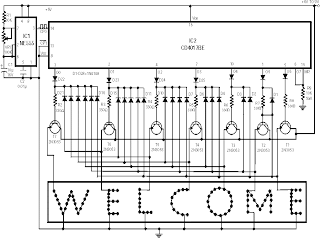A programmable code lock can be used for numerous
applications in which access to an article/gadget is to
be restricted to a limited number of persons. Here is yet
another circuit of a code lock employing mainly the CMOS
ICs and thumbwheel switches (TWS) besides a few other
components. It is rugged and capable of operation on
voltages ranging between 6 and 15 volts. The supply
current drain of CMOS ICs being quite low, the circuit
may be operated even on battery.
The circuit uses two types of thumbwheel switches. switch
numbers TWS1 through TWS8 are decimal-to-BCD converter
type while switch numbers TWS9 through TWS16 are 10-input
multiplexer type in which only one of the ten inputs may
be connected to the output (pole). One thumbwheel switch
of each of the two types is used in combination with IC
CD4028B (BCD to decimal decoder) to provide one digital
output.Eight such identical combinations of thumbwheel
switches and IC CD4028 are used. The eight digital
outputs obtained from these combinations are connected to
the input of 8-input NAND gate CD4068.For getting a logic
high output, say at pole-1, it is essential that decimal
numbers selected by switch pair TWS1 and TWS9 are
identical, as only then the logic high output available
at the Specific output pin of IC1 will get transferred to
pole-1. Accordingly, when the thumbwheel pair of switches
in each combination is individually matched, the outputs
at pole-1 to pole-8 will be logic high.This will cause
output of 8-input NAND gate IC CD4068b to change over
from logic high to logic low, thereby providing a high-
to-low going clock pulse at clock input pin of 7-stage
counter CD4024B, which is used here as a flip-flop (only
Q0 output is used here).The output (Q0) of the flip-flop
is connected to a relay driver circuit consisting of
transistors T1 and T2. The relay will operate when Q0
output of flip-flop goes low. As a result transistor T1
cuts off and T2 gets forward biased to operate the
relay.Switch S1 is provided to enable switching off
(locking) and switching on (unlocking) of the relay as
desired, once the correct code has been set.
With the code set correctly, the NAND gate output will
stay low and flip-flop can be toggled any number of
times, making it possible to switch on or switch off the
relay, as desired. Suppose we are using the system for
switching-on of a deck for which the power supply is
routed via the contacts of the relay. The authorised
person would select correct code which would cause the
supply to become available to the deck. After use he will
operate switch S1 and then shuffle the thumbwheel
switches TWS1 through TWS8 such that none of the switches
produces a correct code. Once the code does not match,
pressing of switch S1 has no effect on the output of the
flip-flop.Switches TWS9 through TWS16 are concealed after
setting the desired code. In place of thumbwheel switches
TWS1 through TWS8 DIP switches can also be used































